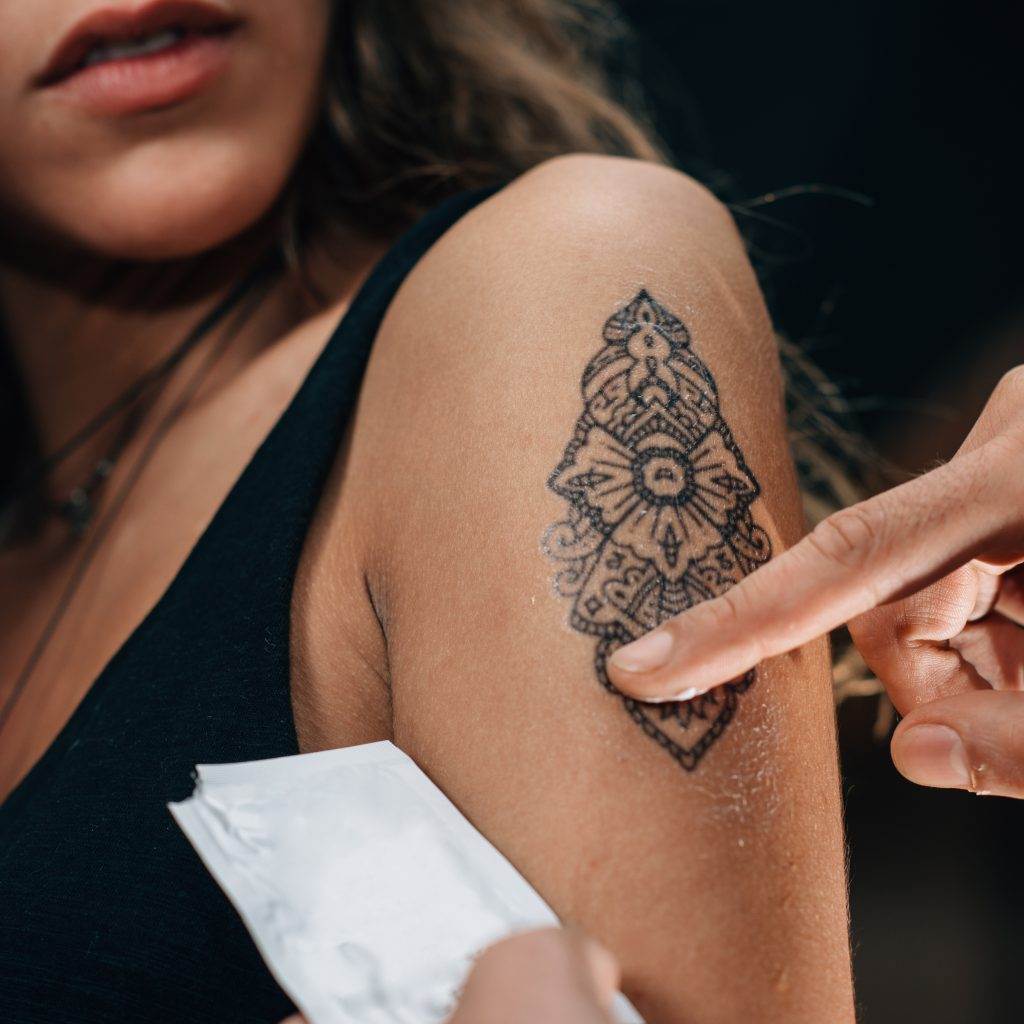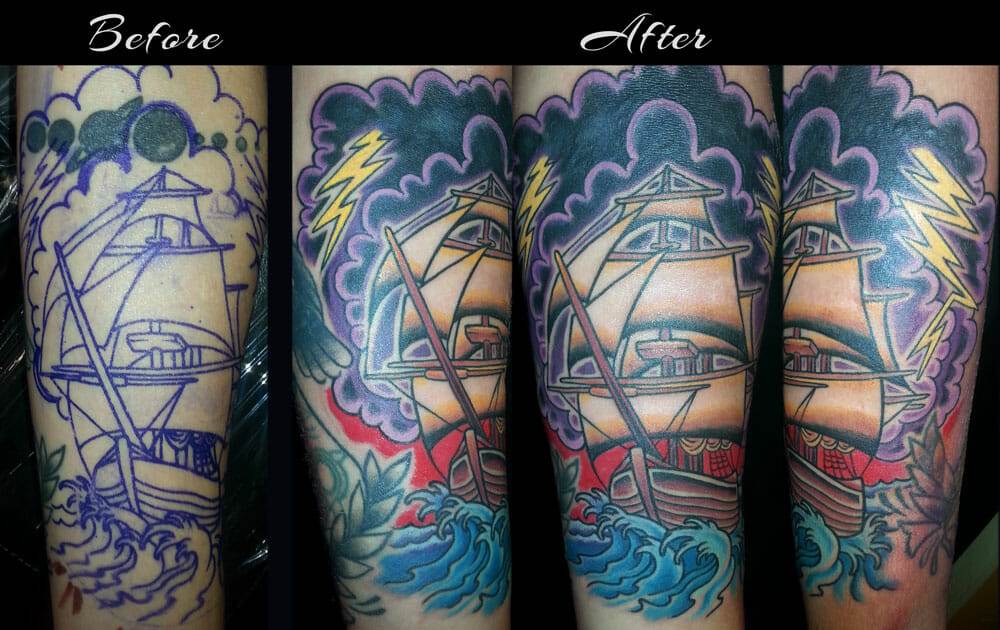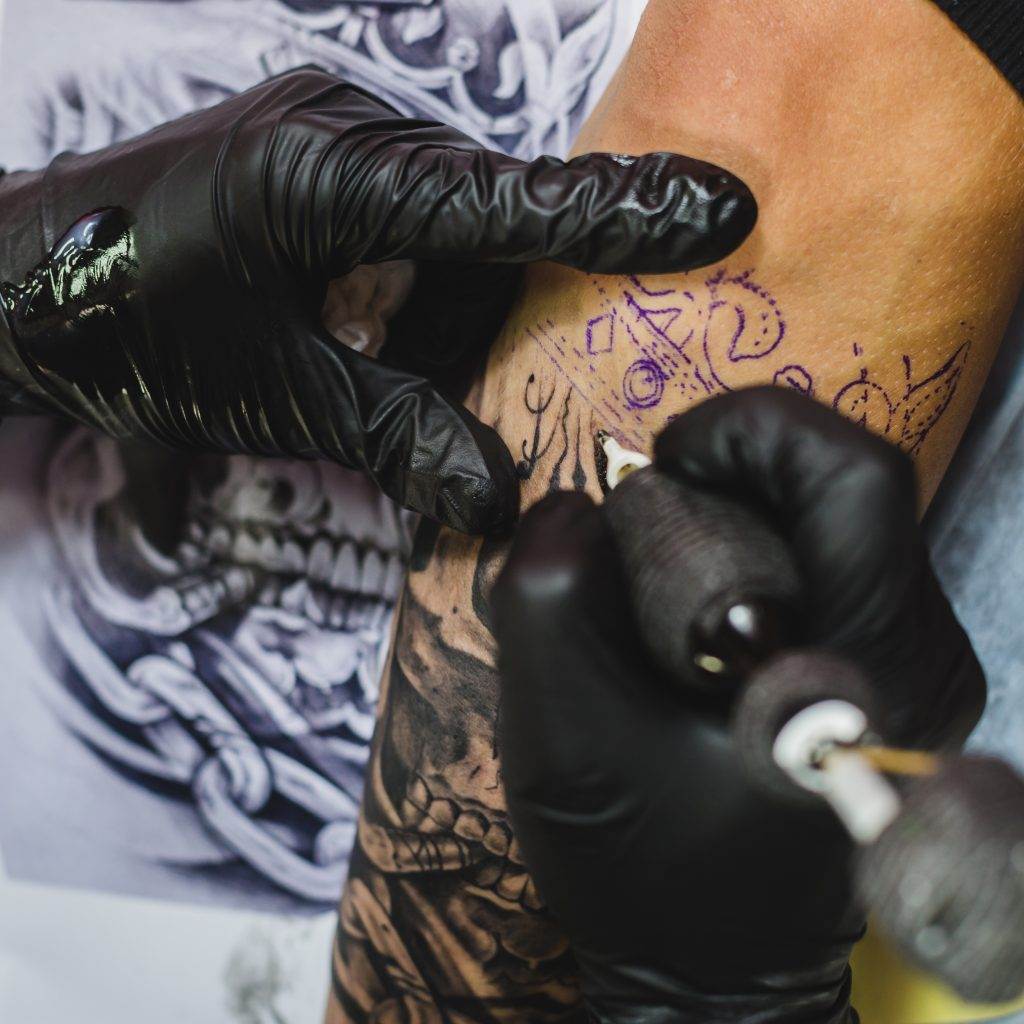Understanding the concept of cover-up tattoos
Cover-up tattoos are a popular option for individuals who want to hide or transform an existing tattoo. These tattoos are strategically designed and inked over the original tattoo, effectively creating a new design that conceals or minimizes the visibility of the old one. The process involves using darker or heavier ink to cover up the previous tattoo.
Factors to consider when getting a cover-up tattoo
- Tattoo Artist Expertise: When getting a cover-up tattoo, it’s crucial to find a skilled and experienced tattoo artist who specializes in cover-up work. They should have the knowledge and expertise to design and execute a cover-up tattoo that effectively covers the old tattoo while ensuring the new design looks visually appealing.
- Size and Placement: The size and placement of the existing tattoo will play a significant role in determining the design and feasibility of the cover-up tattoo. Larger and darker designs generally work better for cover-ups, as they can effectively camouflage the old tattoo. The tattoo artist will assess the size and location of the existing tattoo to determine the best approach for the cover-up.
- Design Options: When considering a cover-up tattoo, there are various design options to choose from. Some people opt for a completely new design that incorporates elements from the original tattoo, while others prefer to completely mask the old tattoo with a new design that has no connection to the previous one. The choice of design will depend on personal preference and the desired outcome.
- Multiple Sessions: Depending on the complexity and size of the cover-up tattoo, it may require multiple sessions to complete. Cover-up tattoos often require more ink and time compared to regular tattoos, as the artist needs to carefully layer the new design to effectively conceal the old tattoo. The number of sessions needed will vary depending on individual circumstances.
- Aftercare: Proper aftercare is essential for allowing the cover-up tattoo to heal correctly and maintain its appearance. Following the tattoo artist’s instructions regarding cleaning, moisturizing, and avoiding sun exposure is crucial to ensure the longevity and success of the cover-up tattoo.
Overall, cover-up tattoos offer individuals a way to transform or conceal unwanted tattoos. By considering factors such as the tattoo artist’s expertise, size and placement, design options, the number of sessions required, and proper aftercare, individuals can achieve satisfying cover-up results.
Assessing Your Existing Tattoo
Analyzing the condition, size, and colors of your existing tattoo
When considering a cover-up tattoo, it is important to carefully assess the condition, size, and colors of your existing tattoo. This evaluation will help determine if a cover-up is a feasible option or if alternative solutions should be considered. Take the time to closely examine your tattoo and consider the following factors:
- Condition: Assess the quality of the lines and shading in your existing tattoo. If the lines are blurry or the colors have faded unevenly, it may be easier to cover up. On the other hand, if the tattoo is heavily saturated or has scar tissue, it could be more challenging to successfully conceal it.
- Size: The size of your existing tattoo will play a significant role in determining the design and feasibility of a cover-up. Larger tattoos generally offer more options for cover-ups, as there is more room to work with. Smaller tattoos may be more difficult to completely hide and may require additional creativity from the tattoo artist.
- Colors: The colors in your existing tattoo will also impact the cover-up process. Darker colors, such as black or navy blue, are generally easier to cover up compared to lighter or vibrant colors. The ability to effectively conceal the original tattoo will depend on how well the new design can incorporate or override the existing colors.
Determining the feasibility of a cover-up
After assessing the condition, size, and colors of your existing tattoo, it’s important to determine the feasibility of a cover-up. This will involve consulting with a skilled and experienced tattoo artist who specializes in cover-up work. They will be able to analyze your existing tattoo and provide expert advice on the best approach for a cover-up.

During this consultation, the tattoo artist will take into account the factors mentioned above and assess if a cover-up is a viable option. They may recommend alternative solutions such as tattoo lightening or removal if they believe a successful cover-up is unlikely.
Being transparent and open with your tattoo artist about your expectations and desired outcome is crucial during this process. They will be able to provide guidance and work with you to create a design that suits your preferences and effectively conceals the original tattoo.
Overall, the assessment of your existing tattoo and determining the feasibility of a cover-up are crucial steps in the cover-up process. By carefully considering the condition, size, and colors of your tattoo and consulting with a knowledgeable tattoo artist, you can make an informed decision on whether a cover-up is the right option for you.
Designing the Cover-Up Tattoo
Incorporating elements to effectively conceal the old tattoo
In designing a cover-up tattoo, it is important to incorporate elements that effectively conceal the old tattoo. This involves the skill and creativity of a professional tattoo artist. Here are a few considerations to keep in mind:
- Placement: The placement of the new design plays a significant role in covering up the old tattoo. The artist may suggest a design that strategically covers the existing tattoo or uses its shape to create a new design.
- Textures and patterns: Incorporating textures and patterns can help to distract the eye from the old tattoo. This could be done through the use of intricate designs or incorporating elements like feathers, flowers, or geometric shapes.
- Negative space: The use of negative space can also be effective in concealing the old tattoo. By strategically leaving areas of the skin untouched, the artist can create a design that camouflages the old tattoo.
Choosing the right colors and styles for the new design
When designing a cover-up tattoo, it is important to choose the right colors and styles to ensure a successful result. Here are some factors to consider:
- Color palette: Depending on the colors in your existing tattoo, the artist may suggest a specific color palette for the cover-up design. Darker colors tend to be more effective in covering up lighter or vibrant colors.
- Style: The style of the new design can help to effectively camouflage the old tattoo. The artist may suggest a particular style, such as realism, watercolor, or blackwork, that will work well in hiding the old tattoo.
- Size and proportion: The size and proportion of the new design should be carefully considered to ensure it covers the old tattoo adequately. This will also help to create a balanced and visually appealing cover-up.
In conclusion, designing a cover-up tattoo requires careful consideration of elements such as placement, textures, patterns, color palette, style, and size. Consulting with a skilled tattoo artist who specializes in cover-up work is crucial to ensure a successful result. By working collaboratively, you can create a cover-up design that effectively conceals the old tattoo and meets your desired aesthetic.
Tattoo Placement and Size
Selecting the optimal placement and size for the cover-up tattoo
When planning a cover-up tattoo, it is crucial to consider the placement and size of the new design. These factors will determine how effectively the old tattoo can be concealed. Here are some tips to keep in mind:
- Considering the existing tattoo: A professional tattoo artist will carefully study the old tattoo and recommend a placement that strategically covers it or incorporates its shape into the new design. This ensures a seamless integration of the cover-up tattoo.
- Taking advantage of negative space: By leaving certain areas of the skin untouched, the artist can use negative space to create a design that effectively camouflages the old tattoo. This technique can help distract the eye from the previous ink.
Ensuring a balanced and cohesive appearance
To create a successful cover-up tattoo, it is important to achieve a balanced and cohesive appearance. Here’s what to consider when selecting the size and proportion of the new design:
- Matching the scale: The size of the cover-up tattoo should be proportionate to the size of the old tattoo. This ensures proper coverage and helps achieve a harmonious overall look.
- Creating a cohesive design: The cover-up tattoo should blend seamlessly with any remaining visible parts of the old tattoo. A skilled artist can choose complementary elements, textures, or patterns that tie the two designs together.
- Considering the overall aesthetic: The cover-up tattoo should align with the individual’s desired style and aesthetic. Whether they prefer realistic, watercolor, or blackwork tattoos, the new design should fit their preferences and vision.
Cover-Up Techniques and Styles

Different cover-up techniques, such as color blending and the use of negative space
Cover-up tattoos can employ various techniques to effectively conceal the old tattoo. Two commonly used techniques include:
- Color blending: By blending new colors with the existing tattoo, a skilled artist can create a design that masks the previous ink. This technique works particularly well when covering up tattoos with vibrant or dark colors.
- Negative space: Utilizing negative space can help divert attention from the old tattoo. By strategically leaving areas of the skin untouched, the artist can form a new design around the existing ink, resulting in an effective cover-up.
Exploring popular cover-up styles, such as geometric and watercolor
When choosing a cover-up style, individuals have a wide range of options. Some popular styles include:
- Geometric: Geometric designs, characterized by clean lines and intricate patterns, can effectively cover up old tattoos. The structured nature of these designs allows for precise placement and coverage.
- Watercolor: Watercolor tattoos, known for their soft and flowing appearance, can be used to create a painterly effect over the existing tattoo. This style utilizes translucent colors to blend the old and new designs seamlessly.
In conclusion, selecting the right placement, size, techniques, and style are crucial when planning a cover-up tattoo. By consulting with a professional tattoo artist, individuals can achieve a seamless and harmonious cover-up that effectively conceals the old tattoo and aligns with their desired aesthetic.



